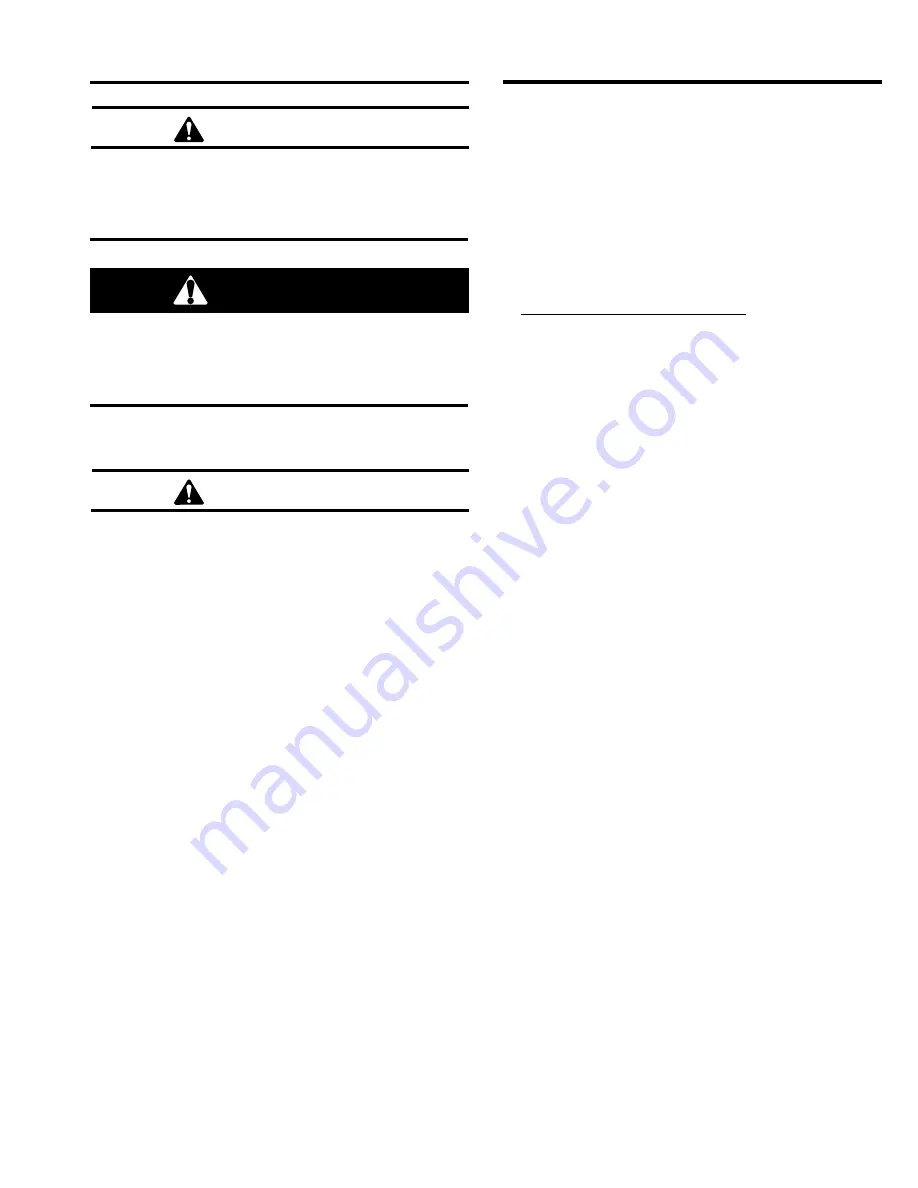
APOLLO 20 LP SUPPLIED-AIR RESPIRATOR
Page 2
WARNING
“Warning” is used to indicate a potentially haz-
ardous situation which, if not avoided, could
result in death or serious injury.
DANGER
“Danger” is used to indicate an imminently haz-
ardous situation which, if not avoided, will result
in death or serious injury.
1.3
Respiratory and Health Alerts
WARNING
TOXIC DUST POISONING
Research by the Occupational Safety and Health
Administration (OSHA) has discovered potential
risks of lead and other heavy metal poisoning to
unprotected abrasive blasting operators and other
personnel who may be exposed to toxic dust in
the abrasive blasting vicinity. Toxic dust is pro-
duced primarily by the removal and breakdown of
lead or other heavy metal coatings during abra-
sive blasting.
The breakdown of toxic coatings and hazardous
abrasive causes the contaminants to become
airborne. Breathing toxic dust from lead or other
heavy metal coatings may cause health and life
threatening toxic poisoning and can damage vital
organs. Breathing hazardous dust produced from
silica abrasive may cause delayed life threaten-
ing respiratory disease such as silicosis.
Lead is one of several toxic dusts that may be
present in an abrasive blasting operation. It is
imperative that blasting contractors identify all
material being removed by blasting, and obtain
material safety data sheets (MSDS) for the blast-
ing abrasive prior to blasting. It is the responsibil-
ity of the employer to identify all airborne con-
taminants in the blast vicinity, and ensure they do
not exceed the permissible exposure limit (PEL)
Ref. 29 CFR 1910.1000 and 29 CFR 1926.62. Thor-
ough examinations should be made by an indus-
trial hygienist or other qualified professional to
identify all contaminants generated by blasting
and in the blasting vicinity.
Exposure to dangerous levels of lead or other
toxic or hazardous dust is not restricted to blast
operators. There may be an equal or greater
danger after the blasting process due to lingering
airborne dust particles, and especially from dust
generated during cleanup activity. Heavy metal
paint, asbestos, sand or other silica, and other
toxic material dusts will cause serious lung dis-
ease or death without the use of properly de-
signed, and maintained NIOSH-approved, sup-
plied-air respirator equipment by blasting opera-
tors and all personnel within the work site area.
Lead poisoning can cause death. OSHA has stated
that the permissible exposure limit of lead is 50
micrograms per cubic meter of air (50
µ
g/m
3
),
averaged over an 8-hour workday.
The Apollo supplied-air respirator system is ap-
proved by NIOSH as a Type-CE, continuous-flow,
abrasive blast, supplied-air respirator, in accor-
dance with title 42 CFR Part 84. The NIOSH recog-
nized assigned protection factor (APF) for any
supplied-air respirator equipped with a loose-
fitting hood or helmet and operated in a continu-
ous flow mode is 25, based upon the NIOSH
Respirator Decision Logic (Pub. No. 87-108). In
other words, any Type-CE respirator should be
used only in atmospheres in which the contami-
nant level does not exceed 25 times the permis-
sible exposure limit. However, in its Memoran-
dum for Regional Administrators dated August
30, 1995, OSHA has stated that select individual
Type-CE continuous-flow, abrasive blast, sup-
plied-air respirator models that pass stringent
tests conducted by independent third party test-
ing laboratories will be granted APF values higher
than the NIOSH recognized 25. Clemco contracted
with Los Alamos National Laboratory to conduct
the independent testing. Based upon the results
of these tests, OSHA will treat the Apollo Sup-
plied-Air Respirator (NIOSH Approval TC-19C-
339) as having an APF of 1000 times the permis-
sible exposure limit, or 50,000
µ
g/m
3
when used in
lead removal applications.
The employer must provide and maintain appro-
priate approved respirators, in addition to provid-
ing operator training and employing required
work site safety practices.
To avoid any potential danger of respiratory in-
jury, approved, supplied-air respirators must be
worn at all times in the presence of any type of
dust. The respirator must be maintained as de-
scribed herein. Improper use of any respirator
may cause life threatening respiratory disease,
and immediate poisoning from toxic dust. Respi-
rators should be removed only after the ambient
air has been tested with a dust monitor, and found
to be safe to breathe.
Toxic dust poisoning may also occur by eating,
drinking, or smoking in a contaminated area, or
by eating, drinking, or smoking in a non-hazard-
ous area before thorough washing of hands and
face. Do not eat, drink or smoke in the blast area.




























